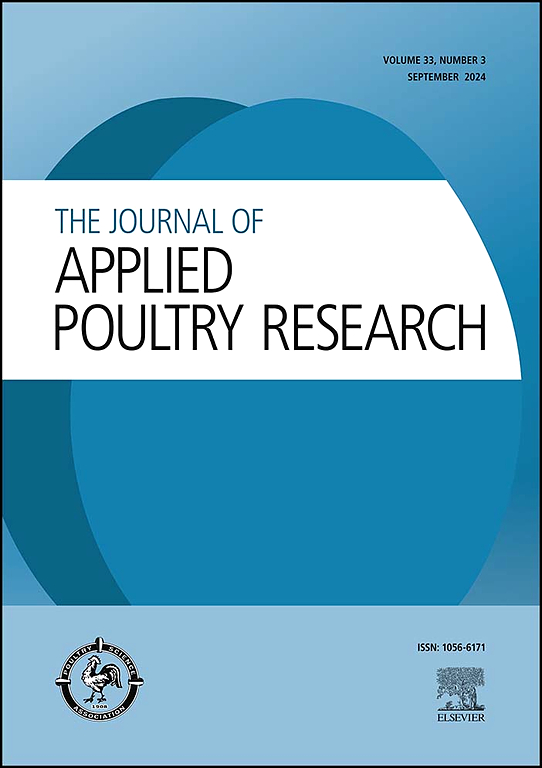评价植酸酶活性和氨基酸密度作为适宜的农场营养分离标记:对肉鸡生产性能、加工产量和骨矿化的影响
IF 2
3区 农林科学
Q2 AGRICULTURE, DAIRY & ANIMAL SCIENCE
引用次数: 0
摘要
颗粒质量和饲料线长度影响整个鸡舍饲料池的营养密度。据报道,氨基酸密度(AAD)和植酸酶活性(PhyAct)在饲料中的变化促使了这项调查。目的是确定在对照田间试验中测量的营养分离对肉鸡生产性能、加工产量和骨矿化的影响。饮食处理采用2 × 3因子随机完全区组设计。从第11 ~ 38期开始,分别饲喂AAD(推荐量的95%和105%)和PhyAct(250、500、750 FTU/kg)的饲粮。试验饲粮中植酸酶释放量为500 FTU/kg;然而,植酸酶在工厂被扣留。随后将液体植酸酶混合到饮食中以产生PhyAct水平。从第11-38天开始测定肉鸡生产性能和骨矿化,在第39天测定肉鸡的加工量。AAD与PhyAct的主要作用无交互作用(P > 0.05)。然而,与降低AAD相比,饲喂过量AAD的肉鸡胴体重提高了121 g,总饲料效率提高了0.077,产奶量提高了1.056% (P < 0.05)。相反,PhyAct的主效应不影响测量参数(P > 0.05)。虽然可以在田间鉴定出AAD和PhyAct的差异,但这些数据表明,AAD是影响生产性能的营养分离的合适标记。由于缺乏肉鸡生产性能差异,因此PhyAct (500 FTU/kg剂量)是一种较差的营养分离标志物。本文章由计算机程序翻译,如有差异,请以英文原文为准。
Evaluating phytase activity and amino acid density as suitable on-farm nutrient segregation markers: Effects on broiler performance, processing yields, and bone mineralization
Pellet quality and feed line length influence the nutrient density in feed pans throughout poultry houses. Reported variability in amino acid density (AAD) and phytase activity (PhyAct) along feed lines prompted this investigation. The objectives were to determine the impact of nutrient segregation, as measured in a controlled field trial, on broiler performance, processing yields, and bone mineralization in a replicated pen trial. Dietary treatments were arranged in a 2 × 3 factorial in a randomized complete block design. Ross 308 male broilers were provided diets varying in AAD (95 % and 105 % of recommendation) and PhyAct (250, 500, 750 FTU/kg) from d11-38. Experimental diets were given full nutrient release credit for phytase at 500 FTU/kg; however, the phytase was withheld at the mill. Liquid phytase was later mixed into diets to create the PhyAct levels. Broiler performance and bone mineralization were measured from d11-38 while processing yields were determined on d39. The main effects of AAD and PhyAct did not interact (P > 0.05). However, broilers fed excess AAD improved d38 BW by 121 g, overall FCR by 0.077, and breast yield by 1.056 % compared to those fed reduced AAD (P < 0.05). Conversely, the main effect of PhyAct did not affect measured parameters (P > 0.05). While variability in both AAD and PhyAct can be identified in the field, these data demonstrated that AAD is a suitable marker for nutrient segregation that impacts performance. The lack of broiler performance differences makes PhyAct (500 FTU/kg dose) a poor nutrient segregation marker.
求助全文
通过发布文献求助,成功后即可免费获取论文全文。
去求助
来源期刊

Journal of Applied Poultry Research
农林科学-奶制品与动物科学
CiteScore
4.10
自引率
10.50%
发文量
80
审稿时长
104 days
期刊介绍:
The Journal of Applied Poultry Research (JAPR) publishes original research reports, field reports, and reviews on breeding, hatching, health and disease, layer management, meat bird processing and products, meat bird management, microbiology, food safety, nutrition, environment, sanitation, welfare, and economics. As of January 2020, JAPR will become an Open Access journal with no subscription charges, meaning authors who publish here can make their research immediately, permanently, and freely accessible worldwide while retaining copyright to their work. Papers submitted for publication after October 1, 2019 will be published as Open Access papers.
The readers of JAPR are in education, extension, industry, and government, including research, teaching, administration, veterinary medicine, management, production, quality assurance, product development, and technical services. Nutritionists, breeder flock supervisors, production managers, microbiologists, laboratory personnel, food safety and sanitation managers, poultry processing managers, feed manufacturers, and egg producers use JAPR to keep up with current applied poultry research.
 求助内容:
求助内容: 应助结果提醒方式:
应助结果提醒方式:


